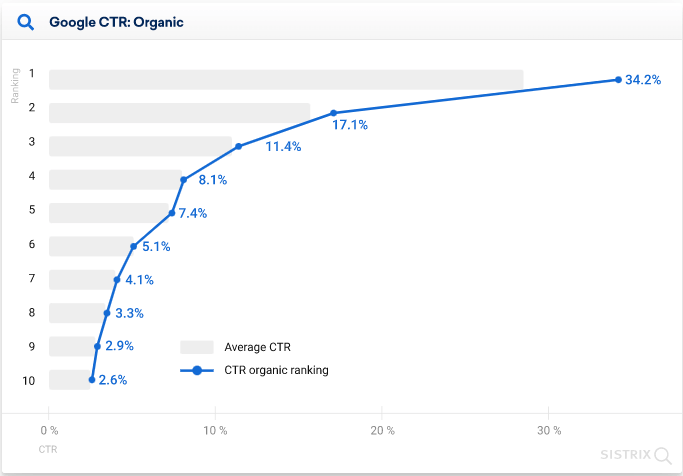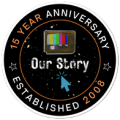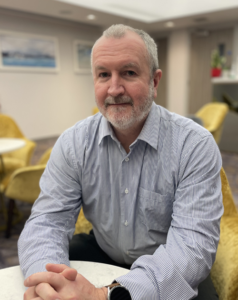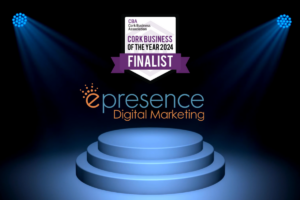A Digital Marketing Professional is Vital for Your Business Success!
Effective Digital Marketing is no longer a DIY function.
Let me immediately start by stating that effective digital marketing is no longer a Do It Yourself function for small businesses, especially not if you are a company that is serious about using digital marketing platforms to achieve real growth. You need the services of a Digital Marketing Professional. ePresence is a professional Digital Marketing Agency in Cork that has assisted many companies across Ireland achieve their Digital Marketing Goals.
There are a number of companies and service providers that imply that you can quickly and easily develop an effective website or online presence on their platforms and your business will just take off overnight. I find this very difficult to believe in the 2020s, simply having a website or online presence is not enough to guarantee success anymore.
I’ve been involved in Digital Marketing for over 13 years now and I’ve seen the digital marketing landscape change considerably the change is not slowing down, in fact, it’s accelerating.
According to internetworldstats.com, the number of internet users has tripled in just the last 11 years to almost 5 billion, that’s over 60% of the world’s population.
Now you might think this is great news for digital marketers, so many more people active online should make it easier for you to reach your potential customers using online marketing platforms, however…….let’s look at the other side of the coin and investigate just how congested the online world has become during this same period.
To succeed in business you have to be able to get the Right Message to the Right Person at the Right Time and to achieve this you must stand out from the crowd.
With a little research you may be able to obtain an accurate idea of who your customer is, but the big challenge today is successfully being able to attract and maintain your customer’s attention in an environment that has become highly competitive and ever more congested.
Let’s just take a quick look at the number of registered websites today. According to internetlivestats.com, the first web page was launched in 1991, today there are almost 2 billion registered domains. The 1 billion mark was originally reached in September 2014 but dropped off slightly before regaining the 1 billion mark permanently in 2016. This means that the number of registered domains has doubled in just the last four years. Almost 1 billion new domains were registered in the last 4 years compared to 1 billion in the preceding 25 years and 2020 is proving to be a busy year online with the arrival of the COVID-19 virus accelerating online adoption by many more companies.
In 2007 Facebook reached 100 000 business pages on its platform, today this number has reached over 60 million registered business pages with over 6 million of these considered to be regularly paid advertisers, according to brandwatch.com. This means there are 600 times more companies present on Facebook than there were just 13 years ago.
LinkedIn has over 30 million companies registered on its platform.
According to Search Engine Land Google processes over 5.4 billion searches per day, the average person performs 3-4 searches per day, and that’s a lot of traffic.
So as you can see although internet usage has increased the presence of companies competing on these platforms for their customer’s attention has increased at a much faster rate making it more difficult to attract potential customers on these platforms, there is so much more competition online today than there was 10-12 years ago. Without a professional and well-designed website that has well-optimised, SEO for Google searches, it’s going to be very difficult to attract potential clients
Contact Us for your Digital Marketing Requirements
Let’s take a deeper look at the journey of Google and Website marketing.
Back when I started developing websites you didn’t need to be a digital marketing professional in 2008 it was quite a simple procedure to get a website to rank on the first page of Google Search Results as long as I followed the basics of SEO. It wasn’t even necessary for a website to be mobile-friendly, in fact, the software I used then, WebPlus didn’t even offer responsive design capabilities so I quickly had to learn a different technology when Mobile Friendly websites became a necessity.
That’s when I got involved with Adobe Dreamweaver. I have since also learned WordPress and most recently I have become a big fan of WebFlow and have been further exposed to WordPress and WooCommerce.
There wasn’t a huge amount of competition in the earlier days and the Google algorithms were more simplistic, which also unfortunately allowed for more Black Hat techniques, thankfully Google is doing a great job in removing these poor-quality sites from their index.
So having a company website that was developed with even basic SEO was enough to ensure that your site ranked well on Google and attracted potential customers to your company. How well a site ranked depended on the competitive nature of each industry.
I developed a website for a client back then using a combination of simple On=Page SEO and Content Marketing which dominated the industry in the client’s geographical region. This website attracted more organic traffic than its five largest competitors put together, I’m not sure this would be so easy to achieve today without the use of greater Technical SEO and copywriting skills. requiring the services of a digital marketing professional.
So what has changed since then?
The short answer is a LOT has changed since then. The sheer number of companies active online has increased considerably making the online marketing world much more competitive.
The platform’s Ranking Algorithms have advanced beyond simple SEO to measure quality and engagement metrics requiring good quality content.
Organic reach has been in decline across all platforms as competition intensifies resulting in, or from, an increase in Paid Advertising.
Engagement and Click-Through Rates are dropping across all platforms as people start to suffer from Content Overload, Banner Blindness and lack of time.
Number of Websites.
The holy grail of SEO or website marketing is to achieve the number 1 Organic Google Ranking Position for as many different, but relevant, Google search keywords/phrases as possible on the Google Search Results Page (SERPs).
If you don’t achieve at least a top 3 ranking for keywords/phrases you won’t receive many website visitors and you won’t get much business.
While every industry, device and search type has slightly different figures the average traffic received, CTR (Click Through Rate) by ranking position on the first page for Google organic search according to Smart Insights is:

If we consider that the number of registered websites has doubled in the last 4 years alone the competition for Google Rankings is getting more and more fierce. Not only is the number of websites increasing, but your competitors are constantly striving to improve their rankings in Google Search Results. It’s an ongoing battle for that elusive top spot requiring the services of a digital marketing professional.
There is only one number 1 ranking position available and it gets the lion’s share of the available traffic with 34.2%. Dropping just one position from position number 1 to number 2 will result in you losing half of your website visitors for that specific search term and dropping to number 3 will result in a 66% loss. A drop of just one or two positions will result in a huge loss of revenue, especially for high-value search terms.
The top 3 positions combined receive over 62% of the available website visitors with the remaining seven positions sharing a meagre 33.5% between them and only 3.8% of potential customers bother to look further than the first page of the Google Search Results. (There are normally 10 organic listings per page.)
The above figures should give you an idea of just how important it is to achieve high-ranking positions in Google Organic Searches for your company website. I’m not going to lie to you achieving top positions will not be an easy task in a competitive environment. It will take knowledge, skill, time and a lot of hard work, but it is well worth the effort in the long run as Organic Traffic is still the best quality traffic.
Google Search Algorithm improvements.
Google is constantly updating its search algorithms in order to provide the searcher with the best quality response or answer to their search query.
Keeping track of the changes is a full-time job for an SEO expert. While Google ranks your website according to over 200 different individual criteria the ultimate goal of Google’s improving algorithms is to downgrade poor-quality spammy websites and promote websites that provide good quality relevant content to their visitors.
Let’s take a look at some of the major algorithm changes over the last 10 years:
1: April 2010 the Mayday Update was a change in how Google assesses which sites are a good match for long-tail enquiries.
2: Feb 2011 The Panda Update, a major update which targeted the quality of content, this update has been improved upon numerous times since then.
3: Nov 2011 The Freshness Update aimed at better determining when to deliver search results that are fresher and to be more relevant to searchers.
4: Jan 2012 The Page Layout Update targeted websites with too many ads above the fold, requiring that visitors scroll down to reach the actual page content.
5: Feb 2012 The Venice Update searches were changed to include results based on the searcher’s location.
6: Apr 2012 The Penguin Update was meant to downgrade websites engaged in aggressive web spam, keyword stuffing, and unnatural linking, this algorithm has undergone numerous updates over the years.
7: Sept 2012 The Exact Match Domain Update downplays the importance of an exact domain match to a search i.e. Electrician in Ireland as a search and a website with a Domain Name of Electrician in Ireland which is a poor quality site.
8: Sept 2013 Hummingbird Update was the first update that tried to understand and return the most relevant results to more complex queries as a result of voice searches.
9: Pigeon Update was a significant local search update.
10: In April 2015 the Mobile-Friendly Update was meant to reward mobile-friendly websites with better search rankings, the effects of this update were increased in May 2016.
11: May 2015 one of numerous Quality Updates to take place over the coming years all designed to target sites with poor or spammy content, poor UX, too many ads, unnatural links etc.
12: Oct 2015 the Rank Brain Update is a machine learning tool that filters search results to help give users the best answer to their query.
13: 2017 through 2019 saw numerous updates that targeted poor-quality websites with low-value content while promoting quality more relevant websites, updates such as Fred and Florida 2.
14: Oct 2019 saw the biggest update in 5 years BERT developed to better understand search queries and further affected Rankings and Featured Snippets.
This is by no means an exhaustive list but it illustrates Google’s intentions to target and punish poor quality low-value websites while promoting websites that provide good quality relevant content to their users and in doing so provide searchers with good quality results to their queries.
You can’t trick the Google algorithms with cheap Black Hat techniques anymore, building a successful online presence takes time and dedication to provide good quality content that addresses your customer’s pain points.
Changes to Google SERP’s Layout Requires a Digital Marketing Professional.
Earlier in this article, we discussed how important it is to obtain a high organic ranking for your company’s website on the Google Search Engine Results Page (SERPs). The value of the top organic positions has declined somewhat in recent years due to changes that Google has made to the Design and Layout of this page brought on by increased demand for Paid Digital Advertising and the increased usage of mobile devices.
Many years ago, before mobile devices, Google clearly separated the results into Organic on the left-hand side of the page and Paid Ads on the right-hand side of the page, thus the number 1 organic result was on the top of the page and often all 10 organic listings were visible on the page.
People tend to trust Organic Results over Paid Listings hence the top-ranking organic listings received a much higher Click Through Rate than they do today. AOL did a study in 2006, reported on by Search Engine Land, and found that the number 1 organic position received 42% of the total possible traffic which is considerably higher than the 34% reported today. In fact, it’s not so easy to refer to the number 1 organic listing today as this position may be taken by a number of different types of results such as a Featured Snippet.
Another reason for the decline in organic CTR is the re-positioning of the Paid Ads from the right-hand side of the page to the top of the page above the Organic Listings. Initially, only 3 ads were allowed, but this has since been increased to 4. Not only has the number of Ads been increased, but the text Ads have been given more real estate and changed visually to be more similar in appearance to the organic listings. Google has even gone so far as to reduce the number of organic listings on the first page from 10 to 7 for certain searches.
This means that organic listings have been pushed further down the page, in many cases even on a larger screen such as a PC or Laptop the Paid Ads take up so much space that it is necessary to scroll down to find the organic listings. A mobile device with a small screen may only have enough display area for the top listing. Add to this the fact that it’s become more difficult to differentiate between a paid listing and an organic listing and it’s easy to understand why the CTR on free organic listings is dropping.

Image sourced from Search Engine Land
Changing Devices and Search Habits.
Back in my early days of Digital Marketing we only had to consider one device when designing websites and that was the PC/Laptop all with screens within a certain size. How things have changed since then.
We now have smartphones with screens measuring a mere 4.7 inches right up to the latest Smart TV by Samsung called The Wall measuring in at a paltry 292 inches and I’m sure we’ll see something bigger in the not-too-distant future.
This naturally presents a challenge when developing a website as it has to not only look good on all devices but has to operate well given the different methods of control available, on a PC we use a mouse, on a smartphone we use fingers, thumbs and pointers, on a larger TV screen we use a remote control with buttons or pointer.
All these devices alter not only alter the way we interact with online platforms but can also alter the way we interact with Google and how we perform searches.
On a PC with a keyboard, we are more likely to type in a multi-word or full sentence type search, but when small smartphones came out typing became a bit more difficult on the small keypad so our typical Google search shortened to just a few necessary words, this has changed again with the advent of Voice Search allowing searchers to speak full sentences or phrases asking more comprehensive questions resulting in optimising for long tail keywords important.
It’s important from an SEO and UX perspective to be aware of the varying nature of the experience that each different type of device offers and how best to design your website accordingly as this will not only affect how your site ranks in Google Searches but will also impact on your Conversions.
Poor Rankings or User Experience will negatively impact your business.
The increase in Paid Advertising.
Google’s Ad Revenue in 2009 was $22.89 billion worldwide. In 2019 it had risen to $134.81 billion and 2020 is looking like passing the 2019 figure quite comfortably with approximately $130 billion in the first nine months. Source Statista.com
Facebook is displaying slightly more rapid growth over the last five years with $39.94 billion in 2017 and is projected to reach $94.69 billion by 2021.
This huge and accelerating increase in Paid Advertising has two effects on your company’s Online Presence:
1: Google and Social Media platforms are giving more priority to paid advertising on their platforms as opposed to free organic traffic. This is evident when we look at how Google has changed the layout of its Search Results Page in recent years. We discussed this in more detail earlier in this article. I looked at my own Facebook and LinkedIn profiles and counted how many posts in my feed were organic and how many were sponsored or paid ads, you might be surprised that as many as 20-25% of the posts are now sponsored and that doesn’t include the paid ads that appear on the top right-hand position on a PC. In fact, LinkedIn and Facebook now offer as many as 7-8 different types of paid ads on their platforms. Organic reach on Social Media platforms has dropped to an average of just 5.2% meaning that only 1 in 20 of your Followers will see your organic posts.
2: The fact that more and more companies are investing in Paid Online Advertising makes paid advertising more competitive which can result in it being more expensive. Most online platforms work on an auction system whereby you compete for Impressions and Clicks against your competitors. The more competition there is for a certain market the more the platforms can charge per Click or Mille (Thousand Impressions.)
Modern companies who are serious about achieving growth will not only have to compete for Organic Traffic through SEO and Content Marketing but will also need to invest in Paid Advertising.
Paid Online Advertising requires in-depth knowledge of Advertising and technical knowledge of how the platforms work. If you don’t know what you are doing you could easily waste a large percentage of your advertising budget and negatively impact your ROI.
Ad Blockers and Banner Blindness.
You may find it hard to believe, but the average person sees over 5000 advertisements daily, many of which are from online sources. This was according to a study performed by Yankelovich in 2007. It is estimated that this figure may be as high as 6000 to 10 000 today.
It’s no wonder that consumers are fighting back by installing ad blockers on their devices, the first of which was launched as far back as 2005.
An Ad Blocker works by recognising the code in typical ads and blocking it, but they are not perfect as advertisers have found technical solutions around these blockers and in some cases have paid the Ad Blockers to White List their adverts which sort of defeats the point of the product.
The fact that these products exist and are growing in popularity shows that there is an increasing trend for consumers to take greater control over their online experience.
The sheer number of ads that a person is exposed to has led to a term called Banner Blindness whereby people consciously or unconsciously ignore adverts that may disrupt their user experience. Internet users are becoming more sophisticated and know where webpage ads are often placed and are simply ignoring these positions by scrolling past them, like the banner on top of the page.
We’ve been exposed to so many ads for so long we simply don’t see them anymore, it’s getting more difficult to grab your customer’s attention.
Summary.
While Digital Marketing may be changing it remains a vital tool in growing the modern business although the landscape may be tilting somewhat in favour of Paid Advertising, there is no denying that Organic Traffic is still the most important traffic a company can acquire on their website or other Online Platforms.
You can only purchase a limited amount of traffic depending on your budget which is generally limited to obvious high-value keywords whereas organic SEO efforts can appeal to a much broader audience and the more lucrative long-tail phrases.
We can further agree that grabbing and maintaining your potential customer’s attention is becoming more challenging as more companies are shifting to online platforms for communication and more platforms are becoming available and appealing to different demographics. Your customer is being overloaded with marketing messages.
Unfortunately for the really small micro-business with virtually no marketing budget, DIY digital marketing may be the only solution, however for any company that has or can raise the budget I strongly advise making use of a digital marketing professional consultant simply because digital marketing is a competition between you and your competitors for your customer’s attention, and there’s little reward for coming second in the race. Give yourself every advantage and make use of the services of a professional digital marketer.
Contact Us for your Digital Marketing Requirements






